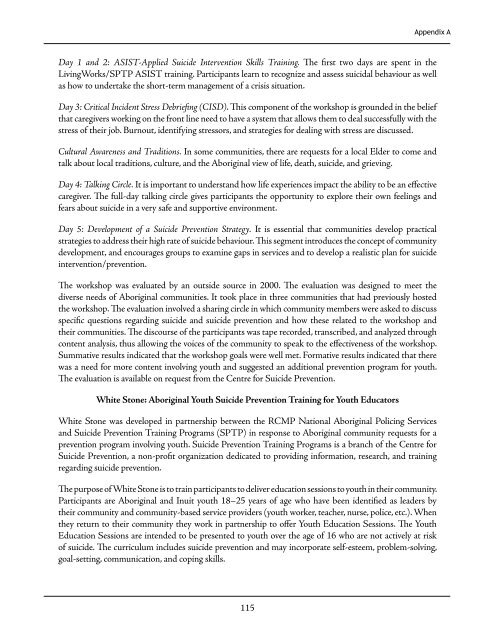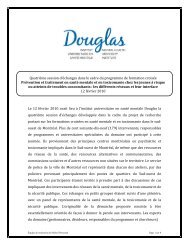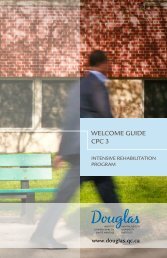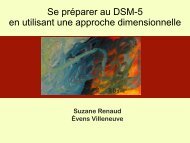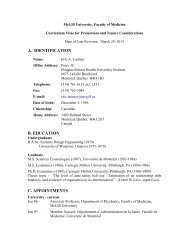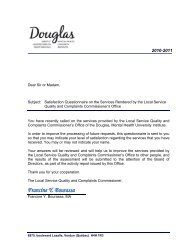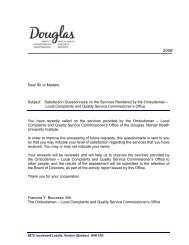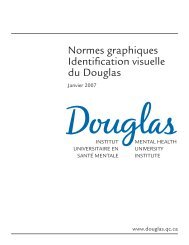Appendix ADay 1 and 2: ASIST-Applied <strong>Suicide</strong> Intervention Skills Tra<strong>in</strong><strong>in</strong>g. The first two days are spent <strong>in</strong> theLiv<strong>in</strong>gWorks/SPTP ASIST tra<strong>in</strong><strong>in</strong>g. Participants learn to recognize and assess suicidal behaviour as wellas how to undertake the short-term management of a crisis situation.Day 3: Critical Incident Stress Debrief<strong>in</strong>g (CISD). This component of the workshop is grounded <strong>in</strong> the beliefthat caregivers work<strong>in</strong>g on the front l<strong>in</strong>e need to have a system that allows them to deal successfully with thestress of their job. Burnout, identify<strong>in</strong>g stressors, and strategies for deal<strong>in</strong>g with stress are discussed.Cultural Awareness and Traditions. In some communities, there are requests for a local Elder to come andtalk about local traditions, culture, and the <strong>Aborig<strong>in</strong>al</strong> view of life, death, suicide, and griev<strong>in</strong>g.Day 4: Talk<strong>in</strong>g Circle. It is important to understand how life experiences impact the ability to be an effectivecaregiver. The full-day talk<strong>in</strong>g circle gives participants the opportunity to explore their own feel<strong>in</strong>gs andfears about suicide <strong>in</strong> a very safe and supportive environment.Day 5: Development of a <strong>Suicide</strong> Prevention Strategy. It is essential that communities develop practicalstrategies to address their high rate of suicide behaviour. This segment <strong>in</strong>troduces the concept of communitydevelopment, and encourages groups to exam<strong>in</strong>e gaps <strong>in</strong> services and to develop a realistic plan for suicide<strong>in</strong>tervention/prevention.The workshop was evaluated by an outside source <strong>in</strong> 2000. The evaluation was designed to meet thediverse needs of <strong>Aborig<strong>in</strong>al</strong> communities. It took place <strong>in</strong> three communities that had previously hostedthe workshop. The evaluation <strong>in</strong>volved a shar<strong>in</strong>g circle <strong>in</strong> which community members were asked to discussspecific questions regard<strong>in</strong>g suicide and suicide prevention and how these related to the workshop andtheir communities. The discourse of the participants was tape recorded, transcribed, and analyzed throughcontent analysis, thus allow<strong>in</strong>g the voices of the community to speak to the effectiveness of the workshop.Summative results <strong>in</strong>dicated that the workshop goals were well met. Formative results <strong>in</strong>dicated that therewas a need for more content <strong>in</strong>volv<strong>in</strong>g youth and suggested an additional prevention program for youth.The evaluation is available on request from the Centre for <strong>Suicide</strong> Prevention.White Stone: <strong>Aborig<strong>in</strong>al</strong> Youth <strong>Suicide</strong> Prevention Tra<strong>in</strong><strong>in</strong>g for Youth EducatorsWhite Stone was developed <strong>in</strong> partnership between the RCMP National <strong>Aborig<strong>in</strong>al</strong> Polic<strong>in</strong>g Servicesand <strong>Suicide</strong> Prevention Tra<strong>in</strong><strong>in</strong>g Programs (SPTP) <strong>in</strong> response to <strong>Aborig<strong>in</strong>al</strong> community requests for aprevention program <strong>in</strong>volv<strong>in</strong>g youth. <strong>Suicide</strong> Prevention Tra<strong>in</strong><strong>in</strong>g Programs is a branch of the Centre for<strong>Suicide</strong> Prevention, a non-profit organization dedicated to provid<strong>in</strong>g <strong>in</strong>formation, research, and tra<strong>in</strong><strong>in</strong>gregard<strong>in</strong>g suicide prevention.The purpose of White Stone is to tra<strong>in</strong> participants to deliver education sessions to youth <strong>in</strong> their community.Participants are <strong>Aborig<strong>in</strong>al</strong> and Inuit youth 18–25 years of age who have been identified as leaders bytheir community and community-based service providers (youth worker, teacher, nurse, police, etc.). Whenthey return to their community they work <strong>in</strong> partnership to offer Youth Education Sessions. The YouthEducation Sessions are <strong>in</strong>tended to be presented to youth over the age of 16 who are not actively at riskof suicide. The curriculum <strong>in</strong>cludes suicide prevention and may <strong>in</strong>corporate self-esteem, problem-solv<strong>in</strong>g,goal-sett<strong>in</strong>g, communication, and cop<strong>in</strong>g skills.115
Appendix AThe Tra<strong>in</strong><strong>in</strong>g for Youth Educators was field tested <strong>in</strong> 2000 to 2001 <strong>in</strong> four locations <strong>in</strong> <strong>Canada</strong> to a totalof 85 participants from 24 communities. An <strong>in</strong>formal evaluation based upon participant feedback, tra<strong>in</strong><strong>in</strong>gteam experience, debrief<strong>in</strong>g, and reflection is ongo<strong>in</strong>g. A rigorous evaluation process was completed <strong>in</strong> 2004by an external evaluator us<strong>in</strong>g surveys, telephone and <strong>in</strong>-person <strong>in</strong>terviews, and document review. Theevaluation (available on request from the Centre for <strong>Suicide</strong> Prevention) <strong>in</strong>dicates that White Stone has apositive impact on its participants and communities. Recommendations are made for cont<strong>in</strong>ued fund<strong>in</strong>g,follow-up, and <strong>in</strong>creased front-end support for communities who br<strong>in</strong>g <strong>in</strong> White Stone.White Stone participants have access to a members-only website to provide them with ongo<strong>in</strong>g support,resources, and onl<strong>in</strong>e community. Participants are able to email questions to White Stone tra<strong>in</strong>ers, share<strong>in</strong>formation, and access additional resources provided by <strong>Suicide</strong> Prevention Tra<strong>in</strong><strong>in</strong>g Programs. Thepurpose of the Tra<strong>in</strong><strong>in</strong>g for Youth Educators component is to tra<strong>in</strong> participants to be a resource to theircommunity. The primary way for participants to be a resource is to present education sessions to youth <strong>in</strong>their community. The Youth Education Sessions are <strong>in</strong>tended to be presented to youth over the age of 16who are not known to be actively at risk of suicide. The sessions are designed to be flexible and responsiveto local needs. The sessions have a life skills development focus and it is expected they will be offered as partof a larger community suicide prevention strategy. The curriculum <strong>in</strong>cludes suicide prevention and may<strong>in</strong>corporate self-esteem, problem-solv<strong>in</strong>g, goal-sett<strong>in</strong>g, communication, and cop<strong>in</strong>g skills. Elders provideopen<strong>in</strong>g and clos<strong>in</strong>g ceremonies for the workshops when applicable. In some communities there is a requestfor a local Elder to come and talk about local traditions, culture, and the <strong>Aborig<strong>in</strong>al</strong> view of life, death,suicide, and griev<strong>in</strong>g.An example of the White Stone program <strong>in</strong> use is the New Brunswick First Nation <strong>Suicide</strong> PreventionTask Force Work Plan. The <strong>Aborig<strong>in</strong>al</strong> New Brunswick task force is comprised of approximately 12 peoplefrom 10 different First Nation communities <strong>in</strong> New Brunswick. Their objective is to:1) provide tra<strong>in</strong><strong>in</strong>g activities and establish a support network for front l<strong>in</strong>e workers and caregivers;2) sensitize the outside world to the unique issues of First Nation people of New Brunswick;3) act as a public relations board; and4) distribute <strong>in</strong>formation about suicide prevention and First Nation people of New Brunswick.The task force works with prov<strong>in</strong>cial organizations such as the New Brunswick Division of the CanadianMental Health Association and the RCMP. Tra<strong>in</strong><strong>in</strong>g programs are offered to the youth of all First Nationcommunities <strong>in</strong> New Brunswick. Recently, the task force organized a White Stone 5-day tra<strong>in</strong><strong>in</strong>g program.Community-Based <strong>Suicide</strong> Prevention Program (CBSPP)The CBSPP is a state-funded program adm<strong>in</strong>istered <strong>in</strong> participat<strong>in</strong>g communities across Alaska by theDivision of Alcoholism and Drug Abuse (ADA) of the Department of Health and Social Services that hasbeen runn<strong>in</strong>g s<strong>in</strong>ce 1988. The purpose of the program is to reduce suicide and self-destructive behaviourwhile encourag<strong>in</strong>g productive and healthy alternatives. Currently, funds are adm<strong>in</strong>istered by the Divisionof Alcoholism and Drug Abuse (ADA) <strong>in</strong> the form of grants averag<strong>in</strong>g approximately US$11,000. Grantsare awarded to organizations with<strong>in</strong> Alaskan villages, which design projects to meet the needs of their owncommunity. While projects must fit with<strong>in</strong> specific constra<strong>in</strong>ts determ<strong>in</strong>ed by the state, the function ofthe state rema<strong>in</strong>s adm<strong>in</strong>istrative, and it is the members of the villages themselves who design and run theprojects. Although changes have been made recently to the grant-writ<strong>in</strong>g and implementation process, <strong>in</strong>116
- Page 1 and 2:
Suicide Among Aboriginal Peoplein C
- Page 3 and 4:
Aboriginal Healing Foundation75 Alb
- Page 6 and 7:
Table of ContentsPreface...........
- Page 8 and 9:
Table of ContentsCultural and Lingu
- Page 10:
PrefaceThis report was prepared und
- Page 14 and 15:
GlossaryAmbivalence - Ambivalence r
- Page 16 and 17:
GlossaryParasuicide - Any acute, in
- Page 18 and 19:
Chapter 1IntroductionWhen I was 14
- Page 20 and 21:
Chapter 1Definitions of Suicide and
- Page 22 and 23:
Chapter 1Methods of Studying Suicid
- Page 24 and 25:
Chapter 1suicide attempts (Marttune
- Page 26 and 27:
Chapter 1A central problem for cros
- Page 28 and 29:
Chapter 2The Epidemiology of Suicid
- Page 30 and 31:
Chapter 2the economic status of Abo
- Page 32 and 33:
Chapter 2No study to date has syste
- Page 34 and 35:
Chapter 2Despite the overall patter
- Page 36 and 37:
Chapter 2Figure 2-6) Average Annual
- Page 38 and 39:
Chapter 2are only a portion of thos
- Page 40 and 41:
Chapter 2Figure 2-9) Suicide Rates
- Page 42 and 43:
Chapter 2Indeed, the rising rate of
- Page 44 and 45:
Chapter 2Figure 2-11) Number of Dea
- Page 46 and 47:
Chapter 2Rate per 100,000 populatio
- Page 48 and 49:
Chapter 2There are only a handful o
- Page 50 and 51:
Chapter 3Origins of Suicide: Indivi
- Page 52 and 53:
Chapter 3Anxiety disorders also car
- Page 54 and 55:
Chapter 3Many of the factors associ
- Page 56 and 57:
Chapter 3American Indians compared
- Page 58 and 59:
Chapter 3genetic and constitutional
- Page 60 and 61:
Chapter 3Single-parent families are
- Page 62 and 63:
Chapter 3Hopelessness, Problem Solv
- Page 64 and 65:
Chapter 3higher rates of suicidal b
- Page 66 and 67:
Chapter 3Physical EnvironmentSuicid
- Page 68 and 69:
Chapter 31990; Chandler, 1994). Thi
- Page 70 and 71:
Chapter 3Risk FactorsDepressionSubs
- Page 72 and 73:
Chapter 4Origins of Suicide: Social
- Page 74 and 75:
Chapter 4Reserves, Settlements, and
- Page 76 and 77:
Chapter 4Traditionalism versus accu
- Page 78 and 79:
Chapter 4are equivalent in seriousn
- Page 80 and 81:
Chapter 4society (Levy and Kunitz,
- Page 82 and 83: Chapter 4those of mother and homema
- Page 84 and 85: Chapter 4Duncan Campbell Scott, Dep
- Page 86 and 87: Chapter 4Traditional Aboriginal com
- Page 88 and 89: Chapter 4Feehan, 1996; Grant, 1996;
- Page 90 and 91: Chapter 4The Child Welfare System a
- Page 92 and 93: Chapter 4Aboriginal communities and
- Page 94 and 95: Chapter 4had extremely high rates.
- Page 96 and 97: Chapter 4Figure 4-2) Transgeneratio
- Page 98 and 99: Chapter 5What Works in Suicide Prev
- Page 100 and 101: Chapter 5Table 5-1) Strategies of I
- Page 102 and 103: Chapter 5Effective Suicide Preventi
- Page 104 and 105: Chapter 5closet rods that give way
- Page 106 and 107: Chapter 5The American Indian Life S
- Page 108 and 109: Chapter 51) school-based and commun
- Page 110 and 111: Chapter 5reduce suicides that follo
- Page 112 and 113: Chapter 5Although they may visit a
- Page 114 and 115: Chapter 6Conclusion: Understanding
- Page 116 and 117: Chapter 6Figure 6-1) An Integrative
- Page 118 and 119: Chapter 6in large urban settings th
- Page 120 and 121: Chapter 6there’s like a program s
- Page 122 and 123: Chapter 6Figure 6-2) Levels of Inte
- Page 124 and 125: Chapter 6Planning and CoordinationA
- Page 126 and 127: Chapter 62) The response to the cri
- Page 128: Chapter 6Often, suicide is a respon
- Page 131: Appendix AASIST participants receiv
- Page 135 and 136: Appendix AThe program has continued
- Page 137 and 138: Appendix Awith the creation and imp
- Page 139 and 140: Appendix AContact Information for R
- Page 142 and 143: Appendix BAdditional Resources: Man
- Page 144: Appendix BAboriginal Healing and We
- Page 147 and 148: Appendix CNational Aboriginal Healt
- Page 149 and 150: References——— (1987). Unravel
- Page 151 and 152: ReferencesBeck, A.T., R.A. Steer, M
- Page 153 and 154: ReferencesBrent, D.A., J.A. Perper,
- Page 155 and 156: References——— (1995). The Pro
- Page 157 and 158: ReferencesDevereux, G. (1961). Moha
- Page 159 and 160: References——— (2005b). In wha
- Page 161 and 162: ReferencesGardiner, H. and B. Gaida
- Page 163 and 164: ReferencesGuo, B. and C. Harstall (
- Page 165 and 166: ReferencesHoberman, H.M. and B.D. G
- Page 167 and 168: ReferencesJong, M. (2004). Managing
- Page 169 and 170: ReferencesKouri, R. (2003). Persona
- Page 171 and 172: References——— (1997). Suicide
- Page 173 and 174: ReferencesMatheson, L. (1996). The
- Page 175 and 176: ReferencesNeimeyer, R.A., B. Fortne
- Page 177 and 178: ReferencesPirkis, J.E., C.E. Irwin,
- Page 179 and 180: ReferencesRutz, W. (2001). Preventi
- Page 181 and 182: References——— (1992). Marriag
- Page 183 and 184:
ReferencesTrimble, J. and B. Medici
- Page 185 and 186:
ReferencesWebb, J.P. and W. Willard


